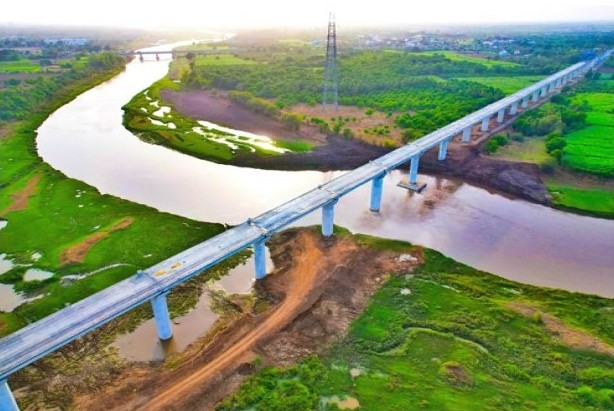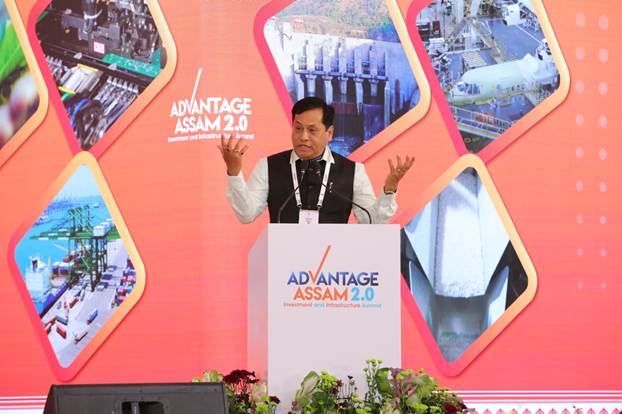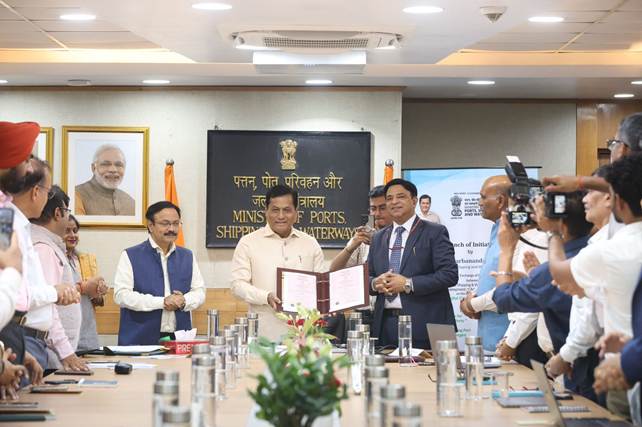National Waterways (Construction of Jetties/Terminals) Regulations, 2025
Maritime News India : In a landmark move aimed at enhancing infrastructure development and attracting private investment, the Ministry of Ports, Shipping and Waterways (MoPSW) has notified the National Waterways (Construction of Jetties/Terminals) Regulations, 2025. Formulated by the Inland Waterways Authority of India (IWAI), these regulations open the doors for private players, public sector entities, and joint ventures to develop, operate, and maintain jetties and terminals across India’s national waterways.
The move is expected to modernize logistics infrastructure, reduce transportation costs, and boost inland cargo movement, aligning with the government’s vision to promote Ease of Doing Business (EoDB). However, beneath this ambitious agenda lies a largely ignored reality of displacement, environmental degradation, and the destruction of traditional river economies.
Moreover this is not just a regulatory tweak — it’s a deliberate push to hand over infrastructure creation, cargo handling, and even terminal operations to private hands, turning rivers into economic highways and monetizable logistics corridors.
Where We Stand Today — A Snapshot of Systemic Failure
Current Statistics (As of FY 2024-25)
-
Navigable length of National Waterways: ~14,500 km
-
Share of IWT in freight movement: 2% (compared to 30% in China and 47% in European Union)
-
Cargo handled on National Waterways:
- 2013-14: 18 million tonnes (MT)
- 2023-24: 133 million tonnes (MT) — Over 7x growth in 10 years
-
Projected cargo target for 2030: 250 million tonnes
-
Cost advantage: IWT offers 30-40% lower transport cost per tonne-km compared to road transport.
Infrastructure Gaps
- Number of operational multimodal terminals (as of 2024): 6 major terminals under JMVP
- Private terminals operational: <15 (most are captive terminals)
- Bottlenecks:
- Lack of last-mile connectivity.
- Shallow draft issues on many stretches.
- Absence of dedicated infrastructure for container handling.
- Regulatory ambiguity in the development of private jetties.
Why Such Pathetic Utilization?
- Decades of policy paralysis.
- Fragmented responsibilities between IWAI, state governments, and local agencies.
- Absence of private capital and zero incentive for logistics players to shift to rivers.
- Outdated terminal designs and bizarre approval processes, where even building a simple jetty required unclear and conflicting permissions
Key Highlights of the Regulations
- Private Participation: Private developers, corporates, and joint ventures can apply to develop permanent or temporary terminals on any national waterway.
- No Objection Certificate (NoC): All terminal developers, including private players, must secure an NoC from IWAI, ensuring compliance with technical and safety norms.
- Digital Application Portal: A dedicated online portal will be launched to process terminal applications, enhancing transparency and efficiency.
- Operational Tenure: Permanent terminals will be operated for lifetime, while temporary terminals will have a 5-year tenure, extendable upon review.
Digital Portal for Terminal Applications
To enhance Ease of Doing Business (EoDB), IWAI is developing an online application portal to streamline and digitise the application process for terminal developers and operators. This digital platform will improve efficiency, transparency, and accessibility, providing a seamless interface for applicants to submit requests and track their progress in real-time.
Emotional & Cultural Connection – Rivers as Mothers
In India, rivers are not just water bodies — they are revered as mothers, nurturers, and divine forces deeply rooted in the spiritual and cultural heritage of the nation. From Ganga Mata, worshipped as the giver of life and cleanser of sins, to Yamuna, Godavari, Narmada, and Brahmaputra, rivers have been sacred lifelines for communities for centuries. Rituals, prayers, and festivals celebrate their purity and generosity, reflecting the profound emotional bond between people and waterways. As economic development accelerates along these rivers through infrastructure projects, it becomes crucial to balance commercial interests with ecological and cultural sensitivity, ensuring that the soul and sanctity of these rivers, cherished as mothers, remain preserved for future generations.
Boosting Cargo Movement & Private Investment
Under the leadership of Prime Minister Shri Narendra Modi and Union Minister Shri Sarbananda Sonowal, cargo movement on national waterways surged from 18 million tonnes in 2014 to 133 million tonnes in 2023-24. The new regulations aim to further accelerate private sector participation, especially under initiatives like the Jalvahak Scheme, which seeks to shift 17% of domestic cargo movement to inland waterways by 2030.
2025 Regulations: A Clear Path to Private Control
The 2025 Regulations are a full-throttle invitation to private players — not just to build, but to own, operate, and profit from jetties and terminals on National Waterways. The key features:
| Feature | What Changes |
|---|---|
| Who Can Build? | Anyone — logistics firms, port operators, agro exporters, even tourism firms. |
| Approval Process | One-time NoC from IWAI, entirely online. No multi-agency circus. |
| Flexibility | Investors design as per their cargo needs — container, bulk, liquid, even cruise terminals. |
| Temporary Jetties | Allowed for 5 years, ideal for seasonal trade routes. |
| Revenue Rights | Handling charges, storage fees, third-party services — all directly to private players. |
This is privatization without ownership transfer — the waterway remains public, but the terminals and revenue streams go to the private sector.
Balancing Economic Growth and Social Impact
Comparing Global Models – How Others Balance Private Participation
| Country | Private Terminals Allowed? | Safeguards for Small Players |
|---|---|---|
| China | Yes, under state-owned backbone | Yes, with price caps & SME quotas |
| Netherlands | Fully private under govt oversight | Yes, with environmental & social safeguards |
| India (2025) | Allowed via NoC system | No clear safeguards yet |
Policy Recommendations for Inclusive Development
Community Access Guarantees – Reserve free/low-cost berths for traditional users, cooperatives, and local traders.
Zoning Rules – Clearly demarcate sections of rivers for community use, beyond commercial terminals.
Environmental & Social Impact Audits – No NoC without comprehensive independent assessments and local consultations.
Public-Private Terminal Mix – Retain some state/cooperative-controlled terminals to prevent monopolistic pricing.
However, this accelerated infrastructure development also brings significant challenges, particularly for rural communities and traditional livelihoods along riverbanks. In areas where new terminals are planned, fisherfolk, boat operators, and small-scale river-dependent economies face the threat of displacement and livelihood disruption. These vulnerable communities, who have lived in harmony with the rivers for generations, may find themselves at the margins of development benefits.
The construction of jetties and terminals, often involving land acquisition, dredging, and industrialisation of riverbanks, can also disturb ecological balance, threaten aquatic biodiversity, and alter natural river flows, impacting both fisheries and agricultural lands dependent on the river’s seasonal rhythms.
Who Will Benefit?
The primary beneficiaries of these regulations will be the Government agencies, who will generate revenue from licensing, concessions, and increased cargo movement, contributing to economic growth and infrastructure expansion. Other beneficiaries include :
1. Logistics Conglomerates
- Private Logistics Giants: Corporates in port operations, logistics, and multimodal transport will gain prime access to key riverine locations, enhancing their supply chain efficiencies.
- Adani Ports, DP World, APM Terminals, and regional logistics firms can now control the entire multimodal chain — from terminal to rail to road.
- Exporters & Importers: Cheaper cargo movement through waterways will significantly cut logistics costs, especially for bulk commodities like coal, cement, and agricultural produce.
- With lower inland transport costs (up to 40% cheaper than road), they can undercut competitors in bulk cargo (coal, fertilizer, cement) and containerized export cargo (steel, auto, agro products).
2. Exporters in UP, Bihar, Assam & Bengal
- Rice from Uttar Pradesh, tea from Assam, and timber from the Northeast get direct, cheaper access to global markets via river-sea connectivity.
- Inland ICDs (Inland Container Depots) along rivers will reduce last-mile trucking costs, boosting global competitiveness.
Private Participation: Investment Driver or Emerging Monopoly?
The regulations create a clear pathway for private terminal ownership on national waterways — a sharp departure from past practices where public-sector ports and terminals dominated. However, industry voices warn that without safeguards, this could lead to:
- Monopolistic control over key stretches of navigable rivers
- Rising access tariffs, squeezing smaller operators and cooperatives
- Potential exclusion of traditional users like fisherfolk and sand miners
- Ecological pressures on fragile river systems if commercial expansion is poorly regulated
Estimated Private Investment (2025-2030)
₹15,000 crore — Expected private capital inflows into terminal development across Eastern India, Northeast, and the Ganga Basin.
Who’s on the Losing Side?
1. Truckers & Road Transport Lobbies
- Bulk transport between coal belts, cement clusters, and ports will shift en masse to waterways, hitting road transport revenue by 12-15% in eastern India.
2. Indian Railways Freight Division
- Already losing share to dedicated freight corridors, Railways will now face serious erosion in bulk cargo (coal, iron ore, food grains) on eastern routes where rivers offer cheaper parallel routes.
3. Informal River Operators
- The hundreds of informal private jetties, especially along the Ganga, Brahmaputra, and Godavari, will be forced into regulatory compliance or face closure.
- Expect massive consolidation, where large firms buy out smaller jetty operators or force them into lease agreements.
Who Will Face Displacement, Job Losses, and Marginalization
1. Displacement of Riverine Communities
The construction of private jetties and terminals will trigger widespread displacement along major rivers like Ganga, Brahmaputra, Godavari, and Mahanadi, impacting:
- Fisherfolk dependent on seasonal fish migration routes.
- Floodplain farmers practicing traditional agriculture along riverbanks.
- Small-scale sand miners who extract river sand for local construction needs.
Estimated Displacement (2025-2030):
At least 15,000 to 20,000 families across India’s major waterways could lose their homes, livelihoods, and access rights, with ripple effects on over 100,000 people whose survival is directly tied to traditional river economies.
2. Collapse of Informal River Transport Economy
- Thousands of unregistered boatmen, ferry operators, and cargo handlers will be pushed out by corporate-operated terminals.
- In states like Bihar, Assam, and West Bengal, where unorganized boat services form a crucial lifeline, these regulations could wipe out entire micro-economies.
Projected Job Losses in Informal Sector:
Over 25,000 boatmen, small ferry operators, and cargo handlers face total loss of livelihoods.
3. Urban Riverfront Evictions
In cities like Patna, Varanasi, Guwahati, and Kolkata, riverside jetties are informally occupied by street vendors, boat repair yards, and religious sites. Privatizing these jetties will:
- Evict informal vendors and settlers.
- Shrink public access to sacred bathing ghats.
- Privatize public riverfronts, reducing cultural access for pilgrims and locals.
No Rehabilitation Framework – The Missing Safety Net
Unlike highways or ports, there is no clear compensation or rehabilitation policy for communities displaced by private jetty projects under the 2025 Regulations. Since many riverside areas are classified as public land or riverbeds, affected families have no formal land rights, leaving them excluded from compensation packages.
- There is no River Livelihood Protection Fund.
- Private developers have no legal obligation to offer resettlement or income restoration programs.
Without clear resettlement rules, displacement will occur in the shadows — undocumented and uncompensated.
Environmental Erosion and Climate Risks
The construction of concrete jetties, embankments, and dredging zones will disrupt natural sediment flows, leading to:
- Accelerated riverbank erosion.
- Increased flood risks for riverside villages.
- Loss of fertile floodplain farmland.
Projected Land Loss Due to Erosion (2025-2030):
Between 4,000-5,000 hectares of prime agricultural and residential land could be lost to flooding, erosion, and dredging impacts.
- In Assam’s Majuli Island, already shrinking, upstream jetty development could intensify erosion.
- Similar risks exist along the Kosi, Gandak, and Krishna rivers, where silt-heavy flows are highly sensitive to dredging and embankment modifications.
The Invisible Loss — Indigenous and Marginalized Voices
- Many displaced communities, especially in Assam, Odisha, Jharkhand, and West Bengal, belong to Scheduled Tribes and marginalized caste groups.
- Their cultural and ancestral ties to riverbanks — including sacred groves, burial sites, and seasonal fishing camps — are entirely ignored in the regulatory framework.
- Loss of riverside access means loss of cultural heritage for many indigenous communities.
Development or Disaster?
The National Waterways (Construction of Jetties/Terminals) Regulations, 2025 promise economic modernization through private investment, but they also expose tens of thousands of vulnerable communities to displacement, livelihood loss, and cultural erasure.
- Winners: Logistics giants, bulk cargo players, and infrastructure developers.
- Losers: Riverine communities, unorganized transporters, informal vendors, and indigenous groups.
Without a comprehensive Displacement and Rehabilitation Policy for Inland Waterways Projects, India’s ambitious waterways development could spark conflict across every major river basin — turning riverbanks into contested spaces where corporate profit and community survival collide.
The cost of this development must not be invisibilized.
Striking the Right Balance
While the National Waterways (Construction of Jetties/Terminals) Regulations, 2025 opens exciting new avenues for investment and infrastructure growth, it also highlights the delicate balancing act between economic development and socio-environmental sustainability. Effective stakeholder consultations, environmental impact assessments, and transparent land acquisition processes will be essential to mitigate negative impacts and ensure that growth is inclusive and respectful of India’s cultural and ecological heritage.
As India’s rivers flow forward into a future shaped by commerce and industry, the challenge will be to preserve their soul as revered mothers and lifelines, ensuring that progress does not come at the cost of displacement, ecological degradation, and cultural erosion.
Status of the development of 26 New National Waterways (NWs) with progress achieved till 31.10.2024:
| Sl. No | NW | Details of Waterways | Length (Km) | Status |
| 1 | NW 1 | Ganga-Bhagirathi-Hooghly River System (Haldia – Allahabad) | 1620 | Jal Marg Vikas Project (JMVP)
Physical progress – 61.79% Financial progress – 61.57% |
| 2 | NW 2 | Brahmaputra River (Dhubri – Sadiya) | 891 | Comprehensive development of NW -2
Physical Progress of the projects: NW-2: 79.87% |
| 3 | NW 16 | Barak River (Lakhipur -Tuker Gram) | 121 | Comprehensive development of NW -16 and IBP Route
Physical Progress: 25.03% |
| 4 | NW 3 | West Coast Canal (Kottapuram – Kollam), Champakara and Udyogmandal Canals | 205 | Physical
Progress of the projects: 47.84%
|
| 5 | NW 4 | Krishna River (Vijayawada – Muktyala) | 82 | |
| 6 | NW 5 | Dhamra-Paradip via Mangalagadi to Pankopal | 233 | |
| 7 | NW 8 | Alappuzha- Changanassery Canal | 29 | |
| 8 | NW 9 | Alappuzha – Kottayam – Athirampuzha Canal | 40 | |
| 9 | NW 27 | Cumberjua River (Cortalim-Ferry to Sao MartiasVidhanParisad) | 17 | |
| 10 | NW 68 | Mandovi River (Usgoan bridge to Arabian Sea) | 41 | |
| 11 | NW 111 | Zuari River (Sanvorden bridge to Marmugao Port) | 50 | |
| 12 | NW 86 | Rupnarayan River (PratapPur to Geonkhali) | 72 | |
| 13 | NW 97 | Sunderbans Waterway (Namkhana to AtharaBankiKhal) | 172 | |
| 14 | NW 40 | Ghagra River (Faizabad to ManjhiGhat) | 345 | |
| 15 | NW 52 | Kali River (Kodasalli Dam to Sadashivgad Bridge, Arabian Sea) | 53 | |
| 16 | NW 44 | Ichamati River (Bridge at Gobra to Bansjhari near Bangladesh Border) | 63 | |
| 17 | NW 57 | Kopili River (Banthai Gaon Tinali Bus Stop to Chandrapur No.2 confluence with Brahmaputra) | 50 | |
| 18 | NW 31 | Dhansiri River (Morongi T.E. village Bridge to Numaligarh) | 110 | |
| 19 | NW 10 | Amba River (Arabian Sea, Dharamtaar Creek to Nagothane ST Stand) | 45 | |
| 20 | NW 28 | Dabhol Creek Vasisti River (Arabian Sea at Dabhol to Bridge at Pedhe) | 45 | |
| 21 | NW 73 | Narmada River (Pandhariya to Gulf of Khambhat) | 226 | |
| 22 | NW 100 | Tapi River (Hatnur Dam to Gulf of Khambhat) | 436 | |
| 23 | NW 37 | Gandak River (Bhaisalotal Barrage to Hazipur) | 296 | |
| 24 | NW 25 | Chapora River (Bridge near Maneri village to Morjim, Arabian Sea) | 25 | The development has been planned upto 2030. |
| 25 | NW 85 | Revadanda Creek – Kundalika River System (Arabian Sea at Revadanda to Bridge near Roha Nagar) | 31 | |
| 26 | NW 94 | Sone River (Sone Barrage, Dehri to Confluence with the Ganga) | 141 |





2 thoughts on “Inland Waterways or a Path to Displacement and Conflict?”